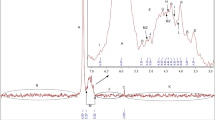Abstract
A greenhouse study was conducted to determine if soil pH affects the requirement for water-soluble P and the tolerance of water-insoluble impurities in TSP fertilizers. Two commercial TSP fertilizers were selected to represent a range in phosphate rock sources and impurities. Phosphate fertilizer impurities were isolated as the water-washed fraction by washing whole fertilizers with deionized water. TSP fertilizers with various quantities of water-soluble P (1.2 to 99% water-soluble P) were simulated by mixing the water-washed fertilizer fractions or dicalcium phosphate (DCP) with reagent-grade monocalcium phosphate (MCP). The fertilizers were applied to supply 40 mg AOAC available P kg−1 to a Mountview silt loam (fine-silty, siliceous, thermic Typic Paleudults). Wheat (Triticum aestivum (L.)) was harvested at 49 and 84 days after planting. Soil pH values at the final forage harvest were 5.4±0.16 and 6.4±0.15. At a soil pH of 5.4, the TSP fertilizers required only 37% water-soluble P to reach maximum yields while at pH 6.4 the fertilizers required 63% water-soluble P. Results of this study show that higher levels of water -insoluble P can be tolerated in TSP fertilizers when applied to acid soils. Phosphorus uptake was not affected by soil pH, but for the mixtures containing the fertilizer residues the source having the lowest level of Fe and Al had a higher relative agronomic effectiveness.
Similar content being viewed by others
References
Allen SE, Terman GL and Clements LB (1976) Greenhouse techniques for soil-plant-fertilizer research. NFDC-TVA Bulletin Y-104
AOAC (1984) Official methods of analysis. 14th ed. Association of Official Agricultural Chemists, Arlington, VA.
Bartos JM, Mullins GL, Sikora FJ and Copeland JP (1991) Availability of phosphorus in the water-insoluble fraction of monoammonium phosphate fertilizers.Soil Sci Soc Am J 55: 539–543
Bartos JM, Mullins GL, Williams JC, Sikora FJ and Copeland JP (1992) Water-insoluble impurity effects on phosphorus availability in monoammonium phosphate fertilizers. Soil Sci Soc Am J 56: 972–976
Chien SH, Adams F, Khasawneh F and Henao J (1987) Effects of combinations of triple superphosphate and a reactive phosphate rock on yield and phosphorus uptake by corn. Soil Sci Soc Am J 51: 1656–1658
Chien SH, Sale PWG and Friesen DK (1990) A discussion of the methods for comparing the relative effectiveness of phosphate fertilizers varying in solubility. Fert Res 24: 149–157
Cope JT Jr, Evans CE and Williams HC (1981) Soil test fertilizer recommendations for Alabama crops. Alabama Agric Exp Stn Circ 251
Dillard EF, Frazier AW, Woodis TC Jr and Achorn FP (1981) Precipitated impurities in 18-46-0 fertilizers prepared from wet-process phosphoric acid. Natl Fert Dev Center Bull y-162. NFDC, Muscle Shoals, AL
Dillard EF and Frazier AW (1983) Precipitated impurities in monoammonium phosphate and their effect on the chemical and physical properties of suspension fertilizers. Natl Fert Dev Center Bull Y-183. NFDC, Muscle Shoals, AL
Frazier AW and Lehr JR (1967) Iron and aluminum compounds in commercial superphosphate. J Agric Food Chem 15: 348–349
Gilkes RJ and Lim-Nunez R (1980) Poorly soluble phosphates in Australian superphosphate: Their nature and availability to plants. Aust J Soil Res 18: 85–95
Gilkes RJ and Mangano P (1983) Poorly soluble, iron-aluminum phosphates in ammonium phosphate fertilizers: Their nature and availability to plants. Aust J Soil Res 21: 183–194
Hue NV and Evans CE (1986) Procedures used for soil and plant analysis by the Auburn University Soil Testing Laboratory. Dep Ser 106. Alabama Agric Exp Stn
Lehr JR (1980) Phosphate raw materials and fertilizers: Part I-A look ahead. In: Khasawneh FEet al. (eds) The Role of Phosphorus in Agriculture, pp 81–120. ASA, CSSA and SSSA, Madison, WI.
Lehr JR (1984) Impact of phosphate rock quality on fertilizer market uses. Ind Miner (London) 200: 127–153
Leon LA, Fenster WE and Hammond LL (1986) Agronomic potential of eleven phosphate rocks from Brazil, Calombia, Peru and Venezuela. Soil Sci Soc Am J 50: 798–802
Lindsay WL (1979) Chemical Equilibria in soils. John Wiley and Sons, New York
Mehlich A (1953) Determinations of P, Ca, Mg, K, Na and NH4 by North Carolina soil testing laboratories. Mimeo. North Carolina State University, Raleigh
McClellan GH and Gremillion LR (1980) Evaluation phosphatic raw materials.In Khasawneh FEet al. (eds). The Role of Phosphorus in Agriculture, pp 43–80. ASA, CSSA and SSSA, Madison, WI
Menon RG, Chien SH and Abd el Nabi Gadalla (1991) Phosphate rocks compacted with superphosphates vs. partially acidulated rocks for bean and rice. Soil Sci Soc Am J 55: 1480–1484
Mullins GL (1988) Plant availability of P in commercial superphosphate fertilizers. Commun Soil Sci Plant Anal 19: 1509–1525
Mullins GL and Evans CE (1990) Field evaluation of commercial triple superphosphate fertilizers. Fert Res 25: 101–106
Mullins GL, Sikora FJ, Bartos JM and Bryant HH (1990) Plant availability of phosphorus in the water-insoluble fraction of commercial triple superphosphate fertilizers. Soil Sci Soc Am J 54: 1469–1472
Mullins GL, Sikora FJ and Williams JC (1995) Effect of water-insoluble P on the effectiveness of triple superphosphate fertilizers. Soil Sci Soc Am J 59: 256–260
NFDC-TVA (1979) Laboratory manual, General Analytical Laboratory, Division of Chemical Development. Fundamental Research Branch, Muscle Shoals, AL
SAS Institute (1985) SAS for linear models: A guide to the ANOVA and GLM procedures. SAS Institute, Cary, NC
Sikora FJ, Dillard EJ, Copeland JP and Mullins GL (1989) Chemical characterization and bioavailability of phosphorus in water-insoluble fractions of three monoammonium phosphate fertilizers. J Assoc Off Anal Chem 72: 852–856
Webb JR and Pesek JT (1958) An evaluation of phosphorus fertilizers varying in water-solubility: I. Hill applications for corn. Soil Sci Soc Am Proc 22: 533–538
White MS (1976) Compounds formed in the manufacture of superphosphate from the phosphates of Christmas and Nauru Islands and Queensland. NZ J Sci 19: 421–431
Author information
Authors and Affiliations
Rights and permissions
About this article
Cite this article
Mullins, G.L., Sikora, F.J. Effect of soil pH on the requirement for water-soluble phosphorus in triple superphosphate fertilizers. Fertilizer Research 40, 207–214 (1994). https://doi.org/10.1007/BF00750467
Received:
Accepted:
Issue Date:
DOI: https://doi.org/10.1007/BF00750467




